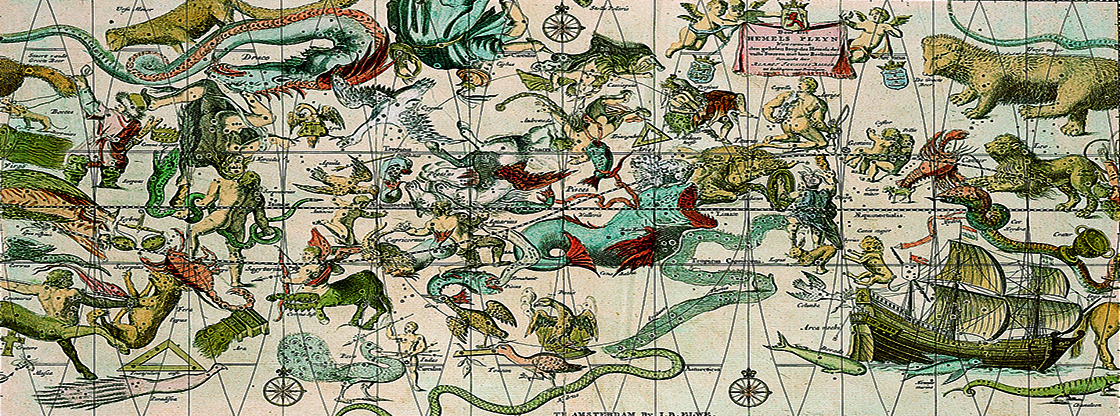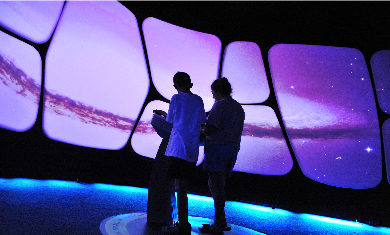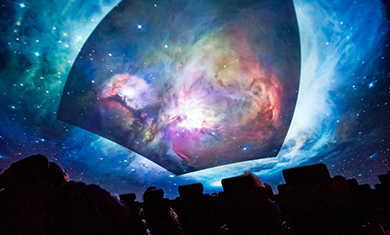Collections

Explore our extensive collection of world-class astronomical objects.
The Adler Planetarium is home to one of the largest and most significant collections of historic scientific instruments in the world. Our collection tells the story of astronomy around the world through instruments, cultural artifacts, and books from the early medieval period through the Space Age. Our artifact collection comprises nearly 3,000 objects, and our library of rare books includes more than 3,000 titles. Our collection holdings also include archives and records that preserve our institutional history, and the history of astronomy.
Objects On Display In Exhibits
Objects from our collection can be found throughout the museum in our exhibition spaces, including Stargazer’s Hub, Mission Moon, Universe In Your Hands, and Chicago’s Night Sky. These exhibits feature some of the rarest and most unusual objects in our collection, including one of the world’s oldest telescopes!
You can also get a behind-the-scenes look the historic artifacts in our collection (both on and off display) with our collections team on social media!
Collections Catalog Resources and Research
The Adler Planetarium’s online collections catalog allows anyone and everyone to search our digitized collection of objects, books, historical photographs, and archival materials. For more information about a particular object or book, please email astrohistory@adlerplanetarium.org.
Online Resources For Students And Researchers
For rights and reproductions requests, please email astrohistory@adlerplanetarium.org.
For research appointments, download and fill out the Research Request Form below and submit to astrohistory@adlerplanetarium.org
Download Research Request Form
Google Arts & Culture Digital Exhibits
Our world class collection comes to life through virtual Google Arts & Culture exhibitions. Through these digital exhibits, you’ll be able to explore the human-centered history of astronomy and dive deeper into our collection. Tens of thousands of visitors worldwide have already experienced these 25 online exhibitions and stories that make the Adler a place of discovery and wonder!
For thousands of years, a rich tradition of astronomy and sky knowledge developed in China and around East Asia and eventually met with European ideas and discoveries.
View Connecting the Heavens and Earth Exhibit (English)
View Connecting the Heavens and Earth Exhibit (simplified Chinese)
View Connecting the Heavens and Earth Exhibit (traditional Chinese)
Giant telescopes long embodied the promise of groundbreaking discoveries symbolizing progress, technological prowess, and cultural sophistication.
Meteors and meteorites provide important clues to understand the history of the solar system, the formation of stars and planets, and the origins of life on Earth. Their study has evolved along with many aspects of astronomy: changes in our concept of the universe and our place in it, the knowledge of different types of astronomical objects, and attitudes about how science is made and who can participate in it.
View The Sky Is Falling: Meteors and Meteorites Through History Exhibit
In 1627, Johannes Kepler published Tabulae Rudolphinae, a book that allowed readers to calculate planetary positions with unprecedented accuracy. Kepler designed the book’s main illustration as a visual code asserting his own place in the history of astronomy. Let’s decipher the Kepler code!
More than 1200 years ago, astronomy gained a prominent place in the Islamic world, which stretched from the Iberian Peninsula to the Indian subcontinent. In this exhibit we highlight important contributions of astronomers and instrument makers from the Islamic world, while also highlighting current scholars and educators who study, cultivate, and share this important legacy.
Humans have always looked up to the sky seeking to learn more about themselves and what the future may bring. Astrology evolved side-by-side with astronomy as part of that long quest, leaving an enduring mark in history and culture.
A rare celestial event nearly 400 years in the making. December 21, 2020, marks the first time Jupiter and Saturn will appear to be separated by only the thickness of a dime held at arm’s length. Learn facts about these planets and the planetary scientists studying the geological processes of their moons.
We’re making space science more inclusive for everyone—learning from LGBTQ+ legends of the past and lifting up those who strive for justice and representation in STEM today. We’re shining a light on those who have confronted the prejudice of others and excelled in the face of adversity.
View Our Here, Queer, and Exploring Beyond the Atmosphere Exhibit
Here on Planet Earth, there’s life everywhere we look. But does life exist beyond Earth, and if so, where might we find it? Join the Adler as we meet alien-seeking scientists, and explore the quest to understand life in the universe.
Science, Technology, Engineering, the Arts, and Mathematics (STEAM) have long embodied the promise of understanding our world and making it a better one. For that promise to be fulfilled, younger generations must be exposed to STEAM and be given the opportunity to fully engage with it. In this exhibition, we share how this has been done from the 16th century to the present; bringing together stories from our collections and from Adler programs.
The Adler partners with Latinx astronomers, astrophysicists, astrophotographers, and scientists to demonstrate the amazing contributions of Latinx individuals to these fields, show barriers to be overcome in a field entrenched in racial biases, and provide advice and inspiration to future generations of the Latinx community.
Raíces Bajo Las Estrellas: Rooted Under the Stars (English)
Adler Planetarium se ha unido con astronautas, astrofísicos, astrofotógrafos, y científicos Latinx actuales para demostrar las increíbles contribuciónes de individuos Latinx en estos campos, para enseñar como romper las barreras en un campo lleno de prejuicios raciales, y también para proporcionar concejos e inspiración a las generaciones futuras de la comunidad de Latinas y Latinos.
Raíces Bajo Las Estrellas: Rooted Under the Stars (en español)
The Sun rules over our planetary system and is our main source of light and heat. It occupies a prominent place in cultures around the world, has shaped our sense of time, and remains a gateway to better understand the universe. Join the Adler in celebrating the Sun and solar observing throughout the centuries.
Astronomy and cosmology deal with large scales of space and time, far-flung objects, and high-energy phenomena, all of which defy human imagination. This exhibit celebrates the ingenuity, taste, and skill of scientists, artists, and instrument makers who have helped all sorts of people visualize complex ideas about the Universe and our place in it.
The Adler Planetarium, America’s first planetarium, celebrates its 90th anniversary on May 12, 2020. To commemorate, we look back on nine decades of programs and initiatives that have brought our visitors and communities together under the sky we all share.
50 years ago, the crew of Apollo 13 were on their way to the Moon when a major accident occurred. Instead of walking on the Moon, crew members Jim Lovell, Fred Haise, and Jack Swigert had to work together to return to Earth alive. See objects on display at the Adler Planetarium from Apollo and earlier Gemini missions, in addition, you can hear Lovell share his memories and stories about these amazing journeys.
Meet some of the female science communicators who engage their communities with science. We dive into how many have succeeded by utilizing a mutual ground technique that personally connects them with their audience.
View our Women In Science Communication And Utilizing Mutual Ground Exhibit
The night sky has always excited the human imagination, and constellations testify to how different mindsets and cultural sensibilities have been projected onto the stars.
On July 20, 1969, the Apollo 11 mission landed on the Moon, just eight years after President John F. Kennedy promised, “We choose to go to the Moon.” Here we feature stories of those individuals who made the Moon landing possible, in their own words.
Images spanning four centuries reveal changing attitudes towards the participation of women in astronomy and space exploration, and hint at enduring prejudices and stereotypes yet to be eradicated.
View our Picturing Women in Astronomy and Space Exploration Exhibit
In 1977, the artist Frederick J. Brown made a large painting titled “Milky Way” in collaboration with the Adler Planetarium. This work resonates with a longstanding quest to understand our place in the universe – a quest where artistic imagination, sensibility, and skill are by no means foreign.
The Moon has been a source of wonder, inspiration, and knowledge for all of human history. As people studied and recorded the patterns of the Moon’s movements, they discovered that the Moon was much more than a mysterious light in our sky—it was a place they might be able to visit some day.
Learn how the alleged observation of “canals” in Mars helped set the scenes for an enduring fascination with the red planet.
View our A Martian Sensation: Maps, Delusion, and the Mars Canals Exhibit
The Adler’s Rare Book Collection contains over 3,000 volumes, from first printed editions of medieval astronomical texts to star atlases and astrophysical works that shaped our modern view of the universe.
View our Highlights of the Adler Planetarium: Rare Books & Works on Paper Exhibit








